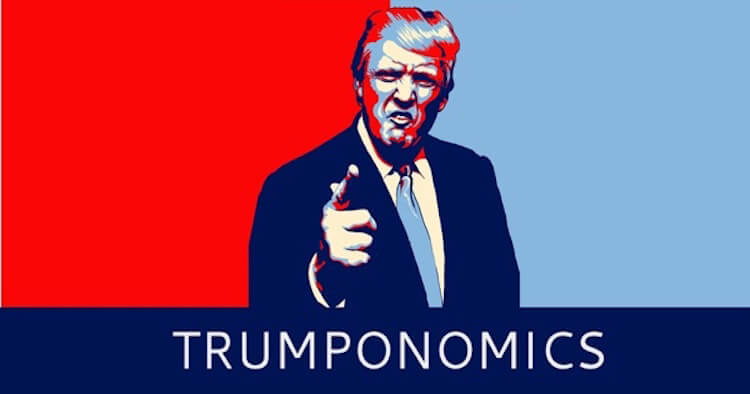What Trumponomics was (2017–2021)
Cut taxes, deregulate, and swing a big tariff stick.
Tax Cuts and Jobs Act (TCJA) lowered corporate and many individual rates. The official scorekeeper for Congress (the Joint Committee on Taxation) estimated roughly $1.5 trillion in revenue reductions over a decade (static score).
Tariffs as leverage: the U.S. used Section 232 to put broad tariffs on steel and aluminum in 2018, and Section 301 to levy waves of tariffs on Chinese goods (Lists 1–4) through 2018-2019. These were the center of Trump’s negotiation strategy with allies and China.
Pre-pandemic economy: growth ran near ~2–3% and the jobless rate fell to a 50-year low (3.5%) by Feb 2020, before COVID hit.
Deficits rose even before COVID (tax cuts + spending), then skyrocketed with pandemic relief. (CBO/JCT scoring above, plus the emergency fiscal packages).
The White House pushed the Fed (often publicly) for lower rates in 2019, an unusual pressure campaign by modern standards. (See contemporaneous reporting on Trump’s calls for zero/negative rates).
Net effect: Businesses got a lower tax burden and lighter regulatory touch; importers faced new costs and uncertainty. Tight pre-COVID labor markets lifted wages at the bottom, but tariff pass-through added some price pressure and retaliation hit some exporters.
What Trump has signaled for 2025+
A more muscular version of the same playbook, especially on trade and immigration.
Across-the-board tariff “baseline”: as a candidate, Trump floated a universal tariff (often described around 10%) on all imports. Analysts interpret this as a standing surcharge that could be varied by country/sector.
Much higher China tariffs: reporting has described plans or support inside Trumponomics circles for very steep tariffs on Chinese imports (figures like 60% have circulated), and subsequent actions in 2025 have taken tariff levels higher and broadened targets.
Continuation/escalation of 301 actions: the previous 301 framework on China remains a live tool; new reviews and actions have been adding tech-related items and higher rates in recent years, a policy thread with bipartisan continuity.
Energy & industrial policy (deal-by-deal): expect permitting leniency for fossil fuels and bespoke pushes to on-shore capacity in politically salient sectors (steel, autos, chips).
Immigration enforcement: promises of the “largest deportation operation” imply a tighter low-skill labor supply, with knock-on effects for wages, prices, and services.
Taxes: push to extend TCJA provisions expiring this term (especially individual-rate cuts and full expensing issues), with the same trade-off, support for investment versus higher deficits.
How those channels hit the economy
Growth & investment
Pro-capex tailwinds: tariff protection + tax extensions can raise after-tax returns for on-shoring in favored sectors (metals, machinery, transport equipment, certain electronics).
But higher input costs & uncertainty: universal tariffs lift costs on all imports, not just China, complicating supply chains and pressuring margins outside the “favored” industries.
Inflation
Tariffs are basically a tax on imports; some share passes through to consumer prices and business costs. Broad, high tariffs are inherently inflationary, especially if the dollar softens or retaliation reshuffles trade.
Labor markets
Tighter immigration enforcement could lift wages in affected industries (construction, agriculture, hospitality, logistics) but also raise costs and reduce capacity, which can feed prices and delay projects.
Budget & rates
Extending the TCJA while avoiding offsetting cuts means larger deficits, putting upward pressure on interest rates and debt service unless growth surprises on the upside. (JCT’s original TCJA score is your baseline for the cost of extensions).
Trade balance & retaliation
Higher tariffs can initially cut imports, but retaliation (or non-tariff barriers abroad) can hurt U.S. exporters, especially agriculture, aircraft, autos & parts, and services.
The good, the bad, and the ugly
The good
Manufacturing capex up in protected sectors; more domestic energy supply can anchor U.S. industrial costs.
Wage gains in lower-wage occupations if labor supply tightens.
Political clarity can spur “go/no-go” decisions on marginal U.S. plants.
The bad
Tariff inflation + deficit-driven rate pressure is a tough combo for small businesses and housing.
Broader import costs hit consumer real incomes outside the tariff-favored sectors.
The ugly
Escalation spiral: broad tariffs prompt retaliation and circumvention (trans-shipment via third countries), fueling more rule changes and whiplash.
Institutional friction: public pressure on the Fed or using emergency trade tools expansively invites legal challenges and policy volatility.
How the rest of the term could play out (base case)
Year 1-2: Announce and phase in the tariff baseline; ratchet China rates higher; push TCJA extensions; accelerate fossil permitting. Inflation bumps modestly; growth stays okay as on-shoring and energy offset some drag. Fed stays cautious; rates drift higher than otherwise.
Year 2-3: Retaliation and circumvention provoke more rules; supply chains adapt, but policy uncertainty smears capex outside protected sectors. Deficits widen with tax extensions; term premium stays elevated.
Year 3-4: Outcomes diverge:
Soft-landing variant: if domestic energy is plentiful and capex delivers productivity, inflation eases and growth holds.
Stagflation variant: if tariffs stay high, immigration stays tight, and rates stay sticky, prices run hot while growth cools, the worst mix for markets and real incomes.
What to watch (your dashboard)
Tariff calendar: effective dates & rates (universal baseline; China-specific schedules).
Tax-policy scoring: credible estimates for TCJA extensions (JCT/CBO).
Import prices & goods CPI: pass-through from tariffs (BLS).
Capex orders & construction spending: proof that reshoring is real, not just rhetoric.
Labor supply & wages in immigration-sensitive sectors.
Deficit and yields: 10-year Treasury vs. core inflation.
Bottom line
Trumponomics 2.0 looks like more of the same, but bigger: high-visibility trade protection, lighter regulation in energy and industry, and an effort to lock in the 2017 tax posture. That mix can deliver capex and jobs in targeted sectors, but it also courts higher inflation, higher borrowing costs, and more trade blowback. If you operate in a protected industry, you’ll likely welcome the tailwinds. If you live on imported inputs, or sell into foreign markets, hedge your costs, diversify suppliers, and plan for policy volatility.


